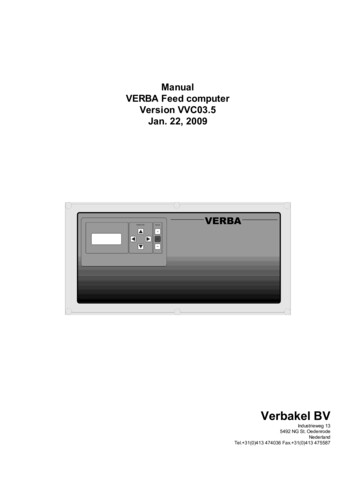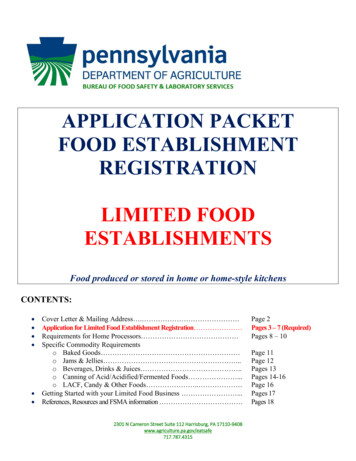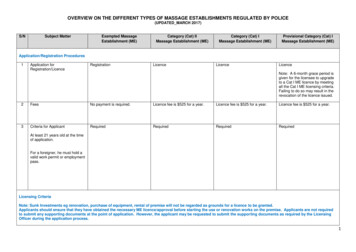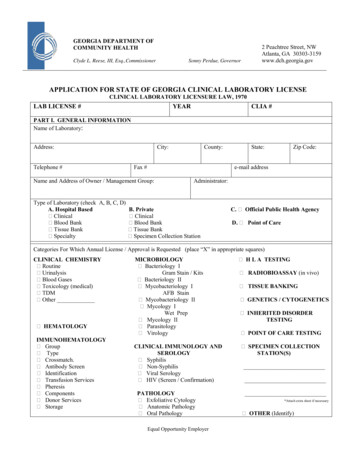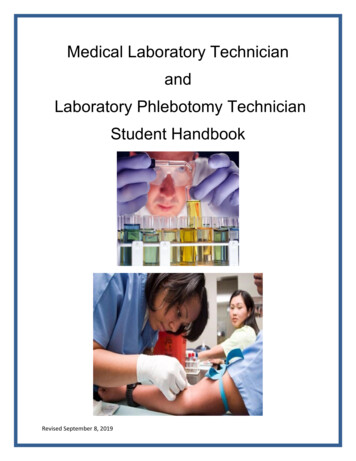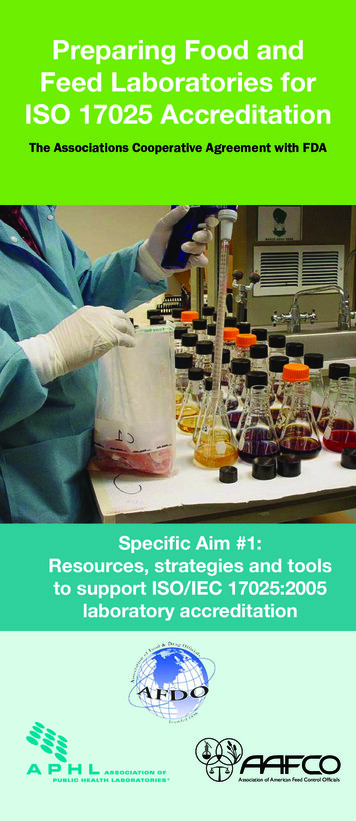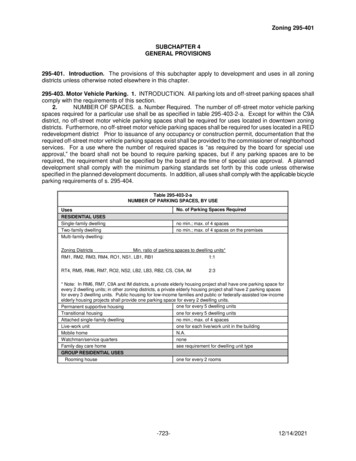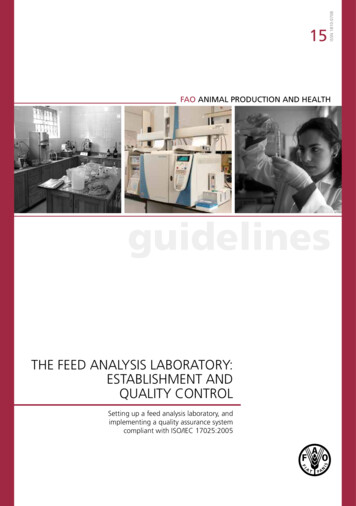
Transcription
ISSN 1810-070815FAO ANIMAL PRODUCTION AND HEALTHguidelinesTHE FEED ANALYSIS LABORATORY:ESTABLISHMENT ANDQUALITY CONTROLSetting up a feed analysis laboratory, andimplementing a quality assurance systemcompliant with ISO/IEC 17025:2005
Cover photographs:Left and centre: L.H. de JongeRight: FAO/Jon Spaull
15FAO ANIMAL PRODUCTION AND HEALTHguidelinesTHE FEED ANALYSIS LABORATORY:ESTABLISHMENT ANDQUALITY CONTROLSetting up a feed analysis laboratory, andimplementing a quality assurance systemcompliant with ISO/IEC 17025:2005AuthorsL.H. de JongeAnimal Nutrition GroupWageningen UniversityThe NetherlandsF.S. JacksonManager, Nutrition LaboratoryMassey UniversityNew ZealandEditorHarinder P.S. MakkarFOOD AND AGRICULTURE ORGANIZATION OF THE UNITED NATIONSRome, 2013
Recommended Citationde Jonge, L.H. & Jackson, F.S. 2013. The feed analysis laboratory: Establishment and quality control.Setting up a feed analysis laboratory, and implementing a quality assurance system compliant withISO/IEC 17025:2005. H.P.S. Makkar, ed. Animal Production and Health Guidelines No. 15. Rome, FAO.The designations employed and the presentation of material in this information product donot imply the expression of any opinion whatsoever on the part of the Food and AgricultureOrganization of the United Nations (FAO) concerning the legal or development status of anycountry, territory, city or area or of its authorities, or concerning the delimitation of itsfrontiers or boundaries. The mention of specific companies or products of manufacturers,whether or not these have been patented, does not imply that these have been endorsed orrecommended by FAO in preference to others of a similar nature that are not mentioned.The views expressed in this information product are those of the author(s) and do notnecessarily reflect the views or policies of FAO.ISBN 978-92-5-108071-9 (print)E-ISBN 978-92-5-108072-6 (PDF) FAO, 2013FAO encourages the use, reproduction and dissemination of material in this informationproduct. Except where otherwise indicated, material may be copied, downloaded andprinted for private study, research and teaching purposes, or for use in non-commercialproducts or services, provided that appropriate acknowledgement of FAO as the source andcopyright holder is given and that FAO’s endorsement of users’ views, products or servicesis not implied in any way.All requests for translation and adaptation rights, and for resale and other commercial userights should be made via www.fao.org/contact-us/licence-request or addressed tocopyright@fao.org.FAO information products are available on the FAO website (www.fao.org/publications) andcan be purchased through publications-sales@fao.org.
ementsChapter 1iiiviiviiiixIntroduction11.1 Background11.2 Aim11.3 A road map of the document2Chapter 2Development of a business plan32.1 Introduction32.2 Approach for development of a business plan32.2.1 Type of laboratory to be developed32.2.2 Market analysis for potential customers and their needs42.2.3 Types of analyses62.2.4 Market analysis for available laboratory services62.2.5 Evaluation and decision making7Chapter 3Setting up and running the laboratory113.1 Introduction113.2 Physical realization of the laboratory113.2.1 The analytical process123.2.2 Methods to be made operational133.2.3 Building and facilities183.2.4 Equipment243.2.5 Organizational structure and responsibilities of personnel263.3 Realization of the laboratory – Procedures273.4 Continuity and improvement of the laboratory28
ivChapter 4Implementation of a Quality Management System and theroad to accreditation314.1 Introduction314.2 Basic principles of quality314.2.1 Technical level324.2.2 Organization level374.2.3 Commercial level404.3 Reading and interpretation of ISO/IEC 17025:2005.414.4 A road map for building a high quality system504.5 First situation: Routine stand-alone feed analysis laboratory504.5.1 Introduction504.5.2 Initial phase514.5.3 First year524.5.4 Second year524.5.5 Third year544.5.6 Fourth year564.6 Second situation: Routine laboratory connected to a feedmanufacturer584.7 Third situation: Laboratory as part of a research organization594.8 Fourth situation: Government or reference laboratories60Sources used63Appendix AEnsuring quality analytical performanceAppendix BFirst line of quality control and the use of Shewhart chartsAppendix CValidation requirements657377Appendix DCalculation of uncertainty of measurement79Appendix EAn example of technical records for a determination81
vAppendix FAn example of a maintenance and calibration documentAppendix GAn example of a training record8385Appendix HProcedure for traceability of volumetric calibrationAppendix ITrend analysis8789
viiForewordFeed has a fundamental influence on productivity, health and welfare of the animal. Feedquality influences animal product quality and safety, and the environment. To achieve balance among these parameters, the animal’s nutritional requirements must be properly met.Confidence in the nutritional information on any feed or feed ingredient provided bysuppliers is critical for buyers because it provides a guarantee of feed quality. Current reportsfrom many countries suggest that manufacturers and buyers do not always have confidencein the data provided from non-accredited laboratories, which can negatively affect marketprices and international trade. It is therefore important that laboratories work towardsadopting a Quality Assurance System for all of their routine feed analyses. This has beendetailed in two FAO Animal Production and Health Manuals: No. 14, Quality Assurance forAnimal Feed Analysis Laboratories, and No. 16, Quality Assurance for Microbiology in FeedAnalysis Laboratories.Not only must the methods used be of an internationally recognized standard, butall steps in the process, from the initial sample submission through to the final reportpreparation, must be traceable. An internationally accredited laboratory gives producersand buyers of feed a great deal of confidence in the data they receive. This provideswider market possibilities for feed manufacturers. Also, the right nutritional informationabout feed ingredients and feeds will enable preparation of balanced diets that meet thenutritional requirements to match the physiological stage of animals and to satisfy thefarmer’s husbandry objectives.This document presents a step-by-step process to guide the laboratory managementteam through the various stages, from planning the feed analysis laboratory building andlayout, to hiring suitable staff and choosing which methods to set up, with appropriateequipment requirements. A detailed guideline for initiating a Quality Management Systemstarts with validation of methods, personnel and training; addresses systematic equipmentmaintenance, calibration, proficiency testing and quality control procedures; and finalreporting and auditing, all culminating in a final accreditation inspection within an estimatedfour-year time frame.The authors have extensive laboratory experience as well as personal experience withsuccessfully bringing non-accredited laboratories up to an internationally recognized accreditation standard. The content of the document has been peer reviewed by a large number ofexperts and their suggestions incorporated. The guidelines presented will assist governmentsand feed manufacturers, as well as a range of institutions, including research and education,to work towards establishment of a feed analysis laboratory – whether as an integral unitor as an independent commercial laboratory – with internationally recognized accreditation.Berhe G. TekolaDirectorAnimal Production and Health Division
viiiAbbreviationsA.U.Absorption UnitAASAtomic Absorption SpectroscopyANOVAAnalysis of varianceCRMCertified Reference MaterialCUSUMCumulative sumFAOFood and Agriculture Organization of the United NationsFAO/IAEAFAO/IAEA Agriculture and Biotechnology LaboratoryGCGas chromatographyGC-FIDGas Chromatography-Flame Ionization DetectorGC-MSGas Chromatography-Mass SpectrometryHPLCHigh Performance Liquid ChromatographyIAEAInternational Atomic Energy AgencyICPInductively Coupled Plasma [Analysis]ICP-AESInductively Coupled Plasma–Atomic Emission SpectroscopyILACInternational Laboratory Accreditation CooperationISOInternational Organization for StandardizationLC-MSLiquid Chromatograph–Mass SpectrometerLIMSLaboratory Information Management SystemLODLimit of DetectionLOQLimit of QuantificationMSMass SpectrometerMS-MSSequential mass spectrometryMUMeasurement of uncertaintyNIRNear-Infrared SpectrometryPRPublic RelationsPSGProject Steering GroupQAQuality AssuranceQMSQuality Management SystemR&DResearch and developmentROIReturn on InvestmentSDStandard deviationSOPStandard operating procedureUVUltraviolet
ixAcknowledgementsWe thank all peer reviewers, listed below, for taking time to critically read this manual andfor their comments and suggestions that led to its improvement.Copy editing and preparation for printing was by Thorgeir Lawrence and layout wascoordinated by Claudia Ciarlantini, which are thankfully acknowledged.Jim BalthropQuality Assurance Manager, Office of the Texas State Chemist,P.O. Box 3160, College Station, Texas 77841, United States ofAmericaRichard A. CowieSenior Quality Assurance Manager, SRUC, Ferguson Building,Craibstone Estate, Aberdeen AB21 9YA, Scotland, UnitedKingdomJohan DeBoeverSenior Researcher Feed Evaluation, Institute for Agricultural andFisheries Research, Animal Sciences Unit, Scheldeweg 68, 9090Melle, BelgiumE. Fallou GuèyeAnimal Production Expert, Animal Production and HealthDivision, FAO, Viale delle Terme di Caracalla, 00153 Rome, ItalyGustavo JaurenaProfessor, Animal Nutrition, Centre of Research and Servicesin Animal Nutrition, Facultad de Agronomía, Univ. de BuenosAires, Av. San Martín 4453 - C1417 DSQ, Ciudad Autónoma deBuenos Aires, ArgentinaAlicia Nájera MolinaInternational Quality Assurance Manager, Masterlab bv, TheNetherlandsE. OdongoAnimal Nutritionist, Animal Production and Health Section, JointFAO/IAEA Division, IAEA, Vienna, Austria,Alfred ThalmannElbinger Str. 10c, D 76139 Karlsruhe, Germany(Formerly: Staatliche Landwirtschaftliche Untersuchungs- undForschungsanstalt Augustenberg; later LandwirtschaftlichesTechnologiezentrum Augustenberg)Anja TöpperHead, Animal Feed Analysis and Microbiology Unit,Landwirtschaftliches Technologiezentrum Augustenberg,Neßlerstraße 23-31, D 76227 Karlsruhe, Germany
1Chapter 1Introduction1.1 BackgroundThe importance of livestock production in developing countries is increasing due togrowing demands for animal products, combined with demands for more sustainableagriculture. Globalization and increased demand for animal products also offer exportopportunities, leading to improved welfare for people from the exporting countries. Keyelements for success, however, are high productivity and low prices, coupled with highquality and safety of animal products. Chemical analyses of diets and animal products playan essential role in achieving optimal production and guaranteeing safety for consumers. Indeveloped countries, it is common practice to undertake most of the analyses in accreditedlaboratories. The availability of this kind of service in developing countries is constraineddue to fewer laboratories and a lack of infrastructure. This can lead to a lack of reliabledata, which can make animal agriculture in developing countries much less competitivelypriced when compared with that in developed countries.The situation in developing countries can be improved by increasing the number oflaboratories and improving the quality of the available analytical services. The provision ofrelevant information and training can be used as a tool to improve the quality of the analytical services in these laboratories. For this purpose, an international group of laboratoryexperts participated in an FAO working group that led to the publication of two manualsdescribing quality assurance, safety issues and analytical methods: Quality assurance foranimal feed analysis laboratories (FAO, 2011), and Quality assurance for microbiology infeed analysis laboratories (FAO, 2013). This group was also the starting point for an FAOnetwork of international experts, aimed at improving analytical capability in developingcountries.Increasing the number of laboratories, however, is a challenging task. The initiativeto start a laboratory lies with local stakeholders and is based on an investment decision.The high investment and the technical complexity can result in hesitation by stakeholdersbecause of a lack of expertise.1.2 AimThe aim of this present document is to present guidelines for starting and running an animalfeed analysis laboratory, including the implementation of quality assurance (QA) systemscompliant with an international standard. To achieve this goal, the relevant information willbe described and illustrated by giving examples wherever appropriate, which should lead toa better understanding by semi-technical persons and decision-makers.
2The feed analysis laboratory: establishment and quality control1.3 A road map of the documentThe document is divided into three parts.The first part (Chapter 2) describes the initial phase of building an animal feed analysislaboratory, a phase especially important for decision-makers and business developers. Somecritical and crucial decisions have to be made during this phase, with such central questionsas: What should the laboratory do? and What are the chances of success in terms of beingan economically viable unit? To answer these questions, stakeholders should first undertakea market analysis and identify any potential customers, their particular requirements, andother business opportunities to make the project viable. This information is necessary tomake a balanced judgement of the potential benefits or profits with respect to the investment required. This document addresses the issue from the point of view of different typesof laboratory. The investments needed for facilities, equipment, consumables and labour(time and skill) will be given for the different types of analyses, including a global priceindication. Using this information, stakeholders should be in a better position to calculateReturn on Investment (ROI).The second part (Chapter 3) of the document deals with the physical creation and running of the laboratory, and is especially important for financers and the laboratory staff.The first section deals, among others, with the physical creation of the laboratory, suchas securing the land; building the laboratory, including the necessary facilities; employingsuitable laboratory personnel; purchasing appropriate equipment; and organizing thelaboratory (placement of various items of equipment and their safe operation). Specialattention is given to pertinent legislation, and health and safety aspects. The second section focuses on the organization of the primary process, from receiving sample material tosending analysis reports and invoices, and management of the laboratory. Crucial elements,such as storage, planning, traceability and confidentiality, are highlighted, and examplesof the related procedures described. Management aspects are separated into internal andexternal. Internal aspects focus on optimization, and increasing efficiency and quality ofthe laboratory processes. This also includes human resource management. External aspectsfocus on improving the market position of the laboratory, including enhancing contactwith customers, identifying new customers, better positioning of the laboratory within themarketplace, establishing contacts with national and international networks on laboratory analyses, participation in conferences that address feed and food analysis issues, andexhibitions of laboratory equipment. Both aspects are important to ensure the successfulrunning of the organization.The third and final part of this document (Chapter 4) describes the implementation ofa QA system, which is especially important for laboratory staff and the QA manager. Thequality of the analytical results produced should be guaranteed to gain the confidenceof customers. The implementation of a complete quality control system can take severalyears of experience and refinement before it can be accredited. In this document, activitiesand their time schedule are described for the implementation of quality principles withthe aim of achieving laboratory accreditation according to ISO/IEC 17025:2005 Generalrequirements for the competence of testing and calibration laboratories, which is an internationally recognized standard for quality systems within testing laboratories. Additionalinformation is also given about implementation of these principles in daily practice.
3Chapter 2Development of a business plan2.1 IntroductionPreparation of a business plan is essential for the creation of a new laboratory. A businessplan describes aims of the laboratory and a plan to realize them. It also assesses challengesin achieving the aims and making a profit, as well as identifying potential opportunities forthe laboratory. The plan can be seen as a road map for the future laboratory to achieveits final goal. The physical creation of a laboratory needs a relatively large investment, andtherefore a good business plan can also help to increase the confidence of potential investors. The realization of a business plan involves a range of experts, including marketingand technical specialists, to provide a realistic plan for the new laboratory on which thenecessary investments can be based.The absence of a business plan can lead to incorrect decisions regarding investments, orto missed opportunities, which could lead to a non-profitable outcome.Two different areas of expertise are necessary: knowledge to assess the market situation and to identify opportunities and challenges; and laboratory knowledge to evaluate types and requirements of potential analyses andthe estimation of laboratory costs.A group to develop a business plan should be created to include personnel with expertise in both the above two areas. They should regularly interact while developing the plan.A suggested approach to realize a business plan is described in the next section. Thisapproach should not be seen as definitive, but rather as a possible tool to create a businessplan. The example approach is limited to chemical analyses.2.2 Approach for development of a business planThe key elements required to prepare a business plan are given in Figure 2.1.2.2.1 Type of laboratory to be developedThe characterization of the laboratory to be created is the first important step. From a commercial point of view, a distinction should be made between a laboratory as a stand-aloneunit, and one embedded in a larger organization. A laboratory could be one of five types: Stand-alone commercial laboratories. These laboratories have an independentjudicial position, working on a commercial basis with the aim to make a profit. Inpractice this means that they largely analyse samples sent from commercial clients. Laboratories integrated with feed producing units. These laboratories are partof a larger organization, but operate as a separate unit within the total chain ofquality control of animal diets and pre-mixes produced. In practice they are used for
4The feed analysis laboratory: establishment and quality controlfigure 2.1Sequential steps in the development of a business plan1. Type of laboratory2. Market analysis for potential customersand their needs3. Types of analyses to be conducted4. Market analysis for available laboratoryservices5. Evaluation and decision-makingthe control of feed ingredients and animal diet specifications. Sometimes they alsoprovide services to others outside their own organization. Laboratories integrated with research organizations. These laboratories areused to analyse samples from experiments performed within a research organization.The analytical work conducted in these laboratories is a mixture of standard analysesand more specific research analyses in a wide range of matrices. These laboratoriescan operate as separate units or be fully integrated within a research division. Laboratories integrated with educational organizations. The primary functionof these laboratories is to provide training opportunities for students. Students mayalso analyse their own research samples. Government or reference laboratories. The function of these laboratories is to bea reference for other laboratories and thereby assist in maintaining and improving thequality of analytical work conducted in the individual laboratories within a country.They are also used by the government for regulatory analyses regarding feed andfood safety.In some situations the laboratories connected to research and educational organizationsalso analyse samples from commercial clients.2.2.2 Market analysis for potential customers and their needsThe next step is to identify and quantify potential customers and their needs. These couldbe producers or users of feed ingredients, such as feed industries, researchers, nongovernmental and governmental organizations. The number and type of clients may varybetween different locations and reflect the level and sophistication of agriculture andlivestock activities in the region. Customers are critical for the revenue of the laboratoryand therefore its commercial existence. Good market analysis is necessary to assess theopportunities for a new laboratory to be economically viable. This analysis should takeinto account the maximum acceptable duration for transport of samples to the laboratory
Development of a business plan(ideally no more than one or two days). It should be noted that differences in regulationsbetween countries may present difficulties in sending samples across internationalborders.The market analysis should be performed using the steps presented below, startingwith an initial analysis based on the current use of analytical services. This should focus on: Number and type of customers. Type of analyses and the amount spent on analytical services. Organization of the analytical services: in-house versus outsourced analysis ofsamples.Customers can be divided into categories relating to the amount they are likely to spendper year on analytical requirements, such as small-scale farmers; small- and medium-scalefeed manufacturing units; and large feed manufacturing mills. Analytical services shouldbe divided into different types of analyses. An obvious division is to separate the analytical services into proximate analyses (i.e. the classic animal feed analyses) and advancedanalyses that use sophisticated instruments (examples being minerals, amino acids andcontaminants). The amount spent on each type of analysis can be roughly calculated byidentifying the number of samples and the prevailing market prices.A division between analytical services performed within the organization and thoseoutsourced to independent commercial laboratories should be made. Some companies mayhave the capability to perform routine analyses in-house, such as nitrogen analysis, which islikely to continue even if a new laboratory offers the same service. The ratio between bothtypes of services strongly affects the opportunities of the new laboratory.The second step should assess additional and potential opportunities in the market thatare likely to utilize the services of the laboratory being established. Attracting new clientsshould be a primary goal, and this could be achieved by offering a more comprehensivetesting facility, faster turnaround time or shorter travel distance than is currently availablein the area, or assisting with interpretation of the results and providing recommendationsabout ration formulation.A critical evaluation should be undertaken to establish why these potential clients woulduse analytical services in the future, but are not currently using the services. Having theability to perform some unique analyses offers clear opportunities for the laboratory andcould strengthen its market position. Its realization, however, will have an impact on investments needed (see Section 2.2.3).The third step is to investigate and predict future market developments. Some important points that can be addressed are: growth of the animal production sector; pressure to produce animal products efficiently and sustainably; national and international legislation for feed and product safety; and volume of feed or feed ingredient export.These issues will require the generation of new information and data, and therefore theneed for analytical services. As part of the market analysis it is important to seek advicefrom local councils as well as national regulators to understand market trends and possiblechanges to legislation. These should be taken into account at the planning stage. Thismarket analysis should be performed for each type of laboratory.5
The feed analysis laboratory: establishment and quality control62.2.3 Types of analysesThe types of analyses conducted by the laboratory affect both its market position in termsof attracting potential customers, and the investment needed. The types of analyses canbe divided into five types:Type 1. Proximate analysesType 2. Macro-mineralsType 3. Micro-minerals at trace levelType 4. Chromatographic analyses (e.g. amino acids, fatty acids)Type 5. Chromatographic analyses at trace levels (contaminants such as aflatoxins,pesticides and pesticide residues, antibiotics, etc.).The types of analyses will determine the investment needed. Proximate analyses areused for feed characterization for general nutritional parameters, and the capacity toperform these analyses should be seen as the minimum requirement for every laboratory.Other types of analysis are more specialized and need specific equipment and facilities. Forminerals and chromatographic analyses, it is important to make a distinction based on therequired detection limit of the samples to be analysed. Determination of trace levels aremostly performed to establish the presence or absence of a contaminant that could affectpublic health, which governments try to protect by legislation (e.g. aflatoxins, pesticides,pesticide residues and antibiotics). Consequently, these determinations not only requirehighly skilled personnel and sensitive and expensive equipment, but also demand a higherlevel of purity of chemicals used (including water) and clean work conditions to avoidcontamination.Types of laboratories can be tentatively categorized as: Basic nutrition laboratory performing only proximate analyses (Type 1 analyses). Laboratory conducting analysis of nutrients; performing proximate, mineral and chromatographic analyses (Types 1 to 4 analyses). Laboratory conducting analysis of nutrients and anti-nutrients (Types 1 to 5 analyses).All animal nutrition laboratories should be able to perform proximate analyses, with thepossibly of extending to analysis of other analytes in the future.It is also possible for a laboratory to sub-contract some analyses if it is not economicallyviable to set up and maintain capability for all types of analyses (this saves customers theinconvenience of sending multiple samples and ensures the laboratory can still secure aportion of the work, and hence income).In order to estimate the investment required to perform different types of analyses, acalculation of the cost to perform the proximate analyses as well as the cost to implementother types of analyses should be made. The cost calculation should include costs for facilities, equipment, personnel and consumables.2.2.4 Market analysis for available laboratory servicesThe next step in the process is to examine the current market situation for performing analytical services, and the opportunities for changing this situation. The success of the newlaboratory depends mostly on the opportunity to take over part of the existing market, soit is therefore important to investigate how much flexibility currently exists. This assessmentshould focus on the following issues:
Development of a business plan Estimation of the number and type of laboratories already present in a specific area.For the characterization of the laboratories, the division as earlier mentioned (Section2.2.1) can be used. This analysis will lead to identification of laboratories that can beseen as competitors for the potential new laboratory. Identification and assessment of the relationship between the laboratories and theclients. This should give information on the amount different clients will spend onobtaining laboratory services. The relationship between clients and a laboratory willbe based on the quality and promptness of services provided to a client. This will alsodetermine their loyalty and personal preference towards a company. Company policymay dictate the flexibility each potential client will have to make a change in theirout-sourcing of laboratory business. Some of this information may be commerciallysensitive and difficult to obtain. Visiting potential clients as part of a Public Relations (PR) exercise can be valuable inestablishing contacts in the industry and establishing an indication of the amount ofanalysis work that could be available and the type of service expected by the clients(e.g. are they dissatisfied with their current suppliers, and if so, for what reason?).2.2.5 Evaluation and decision-makingThe last step in the creation of the business plan is to bring together all the information collected in the previous steps to make an evaluation of the different options. For calculatingprofitability, the evaluation should estimate the potential revenues and costs. This shouldbe done for the different types of laboratories in Section 2.2.1 above.The calculation of the potential revenue should be base
maintenance and calibration; proficiency testing; quality control procedures; reporting; and auditing. THE FEED ANALYSIS LABORATORY: ESTABLISHMENT AND QUALITY CONTROL Setting up a feed analysis laboratory, and implementing a quality assurance system compliant with ISO/IEC 17025:2005 I3535E/1/11.13 ISBN 978-92-5-108071-9 ISSN 1810-0708 9 789251 .



